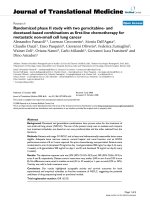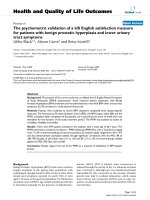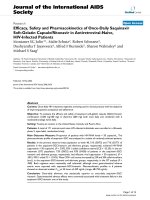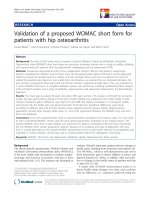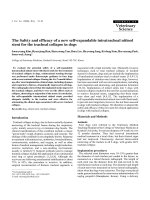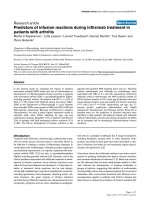Safety and efficacy of temsirolimus as second line treatment for patients with recurrent bladder cancer
Bạn đang xem bản rút gọn của tài liệu. Xem và tải ngay bản đầy đủ của tài liệu tại đây (537.99 KB, 9 trang )
Pulido et al. BMC Cancer (2018) 18:194
/>
RESEARCH ARTICLE
Open Access
Safety and efficacy of temsirolimus as
second line treatment for patients with
recurrent bladder cancer
Marina Pulido1, Guilhem Roubaud2, Anne-Laure Cazeau3, Hakim Mahammedi4, Lionel Vedrine5, Florence Joly6,
Loic Mourey7, Christian Pfister8, Alejandro Goberna1, Barbara Lortal2, Carine Bellera1, Philippe Pourquier9
and Nadine Houédé9,10*
Abstract
Background: Bladder cancer is the 7th cause of death from cancer in men and 10th in women. Metastatic patients
have a poor prognosis with a median overall survival of 14 months. Until recently, vinflunine was the only secondline chemotherapy available for patients who relapse. Deregulation of the PI3K/AKT/mTOR pathway was observed
in more than 40% of bladder tumors and suggested the use of mTOR as a target for the treatment of urothelial
cancers.
Methods: This trial assessed the efficacy of temsirolimus in a homogenous cohort of patients with recurrent or
metastatic bladder cancer following first-line chemotherapy. Efficacy was measured in terms of non-progression at
two months according to the RECIST v1.1 criteria. Based on a two-stage optimal Simon’s design, 15 non-progressions
out of 51 evaluable patients were required to claim efficacy. Patients were treated at a weekly dose of 25 mg IV until
progression, unacceptable toxicities or withdrawal.
Results: Among the 54 patients enrolled in the study between November 2009 and July 2014, 45 were assessable for
the primary efficacy endpoint. A total of 22 (48.9%) non-progressions were observed at 2 months with 3 partial
responses and 19 stable diseases. Remarkably, 4 patients were treated for more than 30 weeks. Fifty patients
experienced at least a related grade1/2 (94%) and twenty-eight patients (52.8%) a related grade 3/4 adverse
event. Eleven patients had to stop treatment for toxicity. This led to recruitment being halted by an independent
data monitoring committee with regard to the risk-benefit balance and the fact that the primary objective was
already met.
Conclusions: While the positivity of this trial indicates a potential benefit of temsirolimus for a subset of bladder
cancer patients who are refractory to first line platinum-based chemotherapy, the risk of adverse events associated with
the use of this mTOR inhibitor would need to be considered when such an option is envisaged in this frail population
of patients. It also remains to identify patients who will benefit the most from this targeted therapy.
Trial registration: ClinicalTrials.gov Identifier: NCT01827943 (trial registration date: October 29, 2012); Retrospectively
registered.
Keywords: Metastatic bladder cancer, Clinical trial, Temsirolimus, mTOR
* Correspondence:
9
INSERM U1194, Montpellier Cancer Research Institute, Montpellier, France
10
Medical Oncology Department, Nimes University Hospital, Nimes, France
Full list of author information is available at the end of the article
© The Author(s). 2018 Open Access This article is distributed under the terms of the Creative Commons Attribution 4.0
International License ( which permits unrestricted use, distribution, and
reproduction in any medium, provided you give appropriate credit to the original author(s) and the source, provide a link to
the Creative Commons license, and indicate if changes were made. The Creative Commons Public Domain Dedication waiver
( applies to the data made available in this article, unless otherwise stated.
Pulido et al. BMC Cancer (2018) 18:194
Background
Bladder cancer is the seventh most common cancer
worldwide in men and occurs at a median age of 73 years
old [1]. Age-standardized incidence rates are higher in
men (9 per 1000.000) than in women (2.2 per 100.000),
which parallel the mortality rates of 3.2 and 0.9, respectively [2]. More than half of cases are occurring in the
most developed areas including Europe and North
America, but significant variations can be observed depending on the countries [2]. Though several risk factors
have been invoked, it is admitted that tobacco use is the
most prevalent one and could be associated with a future rise in incidence [3]. This represents a serious
healthcare burden as bladder cancer is associated with
one of the highest treatment costs [4]. Most bladder cancers are urothelial carcinomas and include the two categories of non-muscle-invasive and muscle-invasive
tumors, the latter representing 20–30% of newly diagnosed cases [5]. While non-muscle invasive tumors are
usually of good prognosis, up to 25% of them progress
to the invasive form of the disease [6]. Transurethral resection of the bladder is the treatment of choice for
non-muscle-invasive bladder cancers and cystectomy is
used for non-metastatic forms of muscle invasive tumors
[7]. In the case of locally advanced tumors or in metastatic diseases, two first-line chemotherapies where cisplatin is associated with either gemcitabine (GC) or
methotrexate, vinblastine, and doxorubicin (MVAC)
have been approved and show overall response rates
above 50% with a median progression-free survival (PFS)
of 7–9 months and a median overall survival (OS) of
12–15 months [8]. Vinflunine was the only drug approved in 2009 as second line therapy based on a
2.4 months benefit as compared to best supportive care
[9], emphasizing the need for new treatment options.
For these patients, blockade of the PD1/PD-L1 immune
checkpoint is an attractive strategy as recent phase II/III
clinical trials showed significant improvement in tumor
response, with a higher response rate for patients with
PD-L1 positive tumor-infiltrating immune cells and a
good tolerability [10]. This led to the approval of pembrolizumab, atezolizumab, durvalumab, nivolumab and
avelumab as second line treatment for platinum pretreated patients [11–15].
With the implementation of tumor collections and the
development of new generation sequencing, a growing
number of potential actionable mutations have been
identified in solid tumors. In bladder cancers, numerous
gene alterations have been reported in a fare percentage
of tumor samples including PTEN deletions, mutations
of FGFR3, TP53, RAS or RAF or mutations of several
key factors of the PI3K/Akt/mTOR signalling pathway
(reviewed in [16]). Deregulation of the PI3K/Akt/mTOR
pathway was associated with remarkable efficacy of
Page 2 of 9
mTOR inhibitors such as rapamycin or everolimus in
bladder cancer cells in vitro and in xenograft models
[17–20]. Temsirolimus or everolimus are approved for
the treatment of metastatic renal cell carcinoma, breast
cancer, mantle cell lymphomas and neuroendocrine pancreatic tumors [21–25].
Two phase II trials have been conducted with everolimus in patients with urothelial cancer who were refractory to first line platinum-based chemotherapy and
showed mild antitumor activity [26, 27]. The study of
Seront et al. reported a prevalence of PTEN loss in nonresponder patients,21 and only few prolonged responses
were associated with the presence of specific mutations
of the TSC1 gene [28]. A phase II trial was also conducted with temsirolimus in the same settings, but was
stopped after the inclusion of 14 patients as no sufficient
benefit was observed on OS, leading to the conclusion
that temsirolimus had poor activity [29].
Here, we report the results of a multicenter, open-label,
single-arm phase II trial evaluating the antitumor activity
of temsirolimus in patients with relapsed bladder cancer
after first-line chemotherapy. The primary objective was
to evaluate the efficacy of temsirolimus in terms of two
months non-progression. Secondary objectives were to
evaluate PFS and OS as well as toxicity. Our study is the
first to provide clinical evidence of a potential benefit of
temsirolimus for the treatment of relapsed bladder cancers. We also discuss the potential use of PET scan (earlyD15 and late-D56 diagnostic performances) as a predictive
value of response to temsirolimus.
Methods
Study design
This is a French multicentre, two-stage, phase II, singlearm, open label clinical trial based on Simon’s two-stage
design assessing the efficacy and safety of temsirolimus
(Torisel®) in patients with urothelial carcinoma of the bladder who relapse after first-line chemotherapy. This study is
registered at ClinicalTrials.gov, number NCT01827943
[30]. It was approved by each local ethics committee and
by the regulatory agencies and was conducted according to
the good clinical practices and the declaration of Helsinki.
Patient selection
Inclusions started in November 2009 from six University
Hospitals and Clinics in France.
Eligible patients had to be 18 years or older with histologically proven locally advanced or metastatic (stage IV)
bladder cancer, an ECOG status ≤2 and a documented
relapse following treatment with a first line platinumbased chemotherapy. All patients included in this trial
had received only a single line of chemotherapy for
metastatic disease prior to temsirolimus. Patients had
measurable lesions on at least one dimension on CT
Pulido et al. BMC Cancer (2018) 18:194
scan according to RECIST criteria v1.1 and did not receive antineoplastic therapy 4 weeks before inclusion.
Also, blood tests were compatible with temsirolimus
prescription following prescription rules indicated for
kidney cancer, most importantly neutrophils > 1500,
platelets > 100,000 and creatinine clearance > 40 mL/
min. Patients with brain metastases (whether symptomatic or not), hypersensitivity to temsirolimus and who
received chemotherapy within a 4 weeks period prior to
inclusion were excluded from the study. All patients
provided a written informed consent prior to inclusion.
Treatment and outcomes
Temsirolimus was administered intravenously at a dose
of 25 mg in a weekly 30 min infusion and was associated
to anti-H1 treatment. One cycle corresponded to 4 weeks
of treatment. Temsirolimus efficacy was evaluated in
terms of non-progression rate at eight weeks. According
to RECIST criteria version 1.1 [31], non-progression is
defined as complete (CR) or partial response (PR) or
stable disease (SD). All partial or complete responses
were confirmed four weeks after the initial documentation by a central blinded radiology review of all imaging.
Secondary outcomes included duration of overall response, one-year progression-free survival (PFS), oneyear overall survival (OS) and toxicity. PFS is defined as
the time from the initiation of treatment to the time of
progression, according to RECIST 1.1 criteria, or death
from any cause. OS is defined as the time from the initiation of treatment to death from any cause. Duration of
overall response is defined as the time from the first
radiological examination showing partial or complete response (whichever is first recorded) to the objectively
documented progression of disease. To be assessable for
the primary endpoint, patients had to meet eligibility criteria and received at least one dose of treatment.
Page 3 of 9
18F FDG. One hour later, a CT scan without contrast
agent was performed, covering the area from the vertex
to the proximal thigh, and the images were used for attenuation correction and image fusion. This was
followed by whole-body 3D PET acquisition with eight
bed positions according to local procedure of emission
scan time each using a dedicated PET/CT scanner.
Image interpretation
FDG-PET/CT scans were centralized reviewed by an experienced blinded nuclear medicine physician. Baseline
and subsequent PET were compared for each patient
using the EORTC criteria. For each patient, a maximum
of 5 lesions were selected at baseline with the highest
18F–FDG uptake in as many organs as possible and
measured at the follow-up scans. We measured SUVmax
according to body surface area as required in EORTC
criteria (SUVmaxbsa) and SUVmax according to bodyweight (SUVmaxbw). SUVmaxbsa measurements from
all target lesions were summed on each scan, giving
∑SUVmax. At the first follow-up and if ∑SUVmax was
decreasing compared with baseline, response was calculated as Δ∑SUVmax between baseline and actual followup divided by baseline ∑SUVmax • 100%. If SUVmax increased, response was calculated as Δ∑SUVmax between
lowest registered and actual follow-up divided by lowest
registered ∑SUVmax • 100%. Response was classified according to the 4 EORTC categories: complete metabolic
response (CMR) with complete resolution of 18F–FDG
uptake within all lesions; partial metabolic response
(PMR) with a reduction of ∑SUVmax of 15–25% after
1 cycle and at least 25% after more than 1 cycle; progressive metabolic disease (PMD) with a ≥ 25% increase of
∑SUVmax corresponding to a visible increase in 18F–
FDG uptake (> 20% in the longest dimension) or to a
new 18F–FDG–avid lesion; stable metabolic disease
(SMD) with a response between PMR and PMD.
Toxicity
Toxicity analysis was performed on all patients who received at least one administration of the study drug. Tolerability and safety were assessed through recording of
adverse events using Common Terminology Criteria for
Adverse Events from NCI (Version 3.0).
FDG-pet/ct
Optional study included PET-scan analysis that was performed at the time of inclusion visit and 15 and 56 days
after inclusion to evaluate early and late diagnostic performance of PET-scan and concordance of PET-scan
with CT-TAP Scan.
Three PET centres were involved using three different
devices but a similar acquisition protocol. After 6 h of
fasting, the blood glucose level of each patient was measured, and the patient was injected with 3 MBq/Kg of
Sample size
Sample size estimation was performed based on the Simon’s optimal two-stage design [32] and calculated with
the npII software [33]. We used unacceptable and acceptable response rates of 20% and 40%, respectively.
We believed that unacceptable response rate of 20% was
clinically relevant for the development of such targeted
therapies in such an indication and that 40% would correspond to the maximum effect that we could hopefully
obtain. It is usually admitted that PFS is probably more
relevant for the evaluation of a targeted therapy as compared to tumor shrinkage used for cytotoxic agents. Indeed mTOR inhibitors were developed based on the
evaluation of PFS in renal cancer. We used respectively,
a 5% type I error rate and a 10% type II error rate (85%
power). The choice of 85% power was chosen
Pulido et al. BMC Cancer (2018) 18:194
deliberately in order to reduce the number of patients
that would be necessary to evaluate temsirolimus efficacy in such a fragile patient population for whom very
few alternatives could be offered at the time of the trial
design. With an anticipated drop-out rate of 10%, 55
subjects were necessary. At the end of the first stage, the
trial would be continued if a minimum of 5 nonprogressions were observed among 17 assessable patients. At the second stage 34 additional assessable subjects would be recruited and ≥15 responses would be
required to claim efficacy.
Page 4 of 9
Included
(n=54)
Not treated N=1
Assessable for toxicity
(n=53)
Excluded N=8
Data analysis
All analyses were descriptive; no p-values were calculated.
Categorical endpoints were reported in terms of counts
and proportions. Non-progression rate at 8 weeks was estimated using binomial estimates and reported with its
95% confidence interval (CI). Continuous endpoints were
reported in terms of summary statistics including number
of patients, median, minimum, and maximum. Survival
endpoints (PFS and OS) were analysed using the KaplanMeier method. The median survival rates were reported
with a 95% CI. Median follow-up was calculated using the
reverse Kaplan-Meier method.
Results
Patients and treatment
This multicentre study was conducted in six centres between November 2009 and July 2014. Among the 54 patients who were enrolled, 9 did not meet the eligibility
criteria. One patient was never treated because of a rapid
progression of the disease. The 8 other patients had
major protocol deviations: ECOG 3 status (1), upper
tract urothelial carcinoma (1), prostate adenocarcinoma
pT2 (1), two lines of chemotherapy for metastatic dis����������������������������������������������������������������������������������������������������������������������������������������������������������������������������������������������������������������������������������������������������������������������������������������������������������������������������������������������������������������������������������������������������������������������������������������������������������������������������������������������������������������������������������������������������������������������������������������������������������������������������������������������������������������������������������������������������������������������������������������������������������������������������������������������������������������������������������������������������������������������������������������������������������������������������������������������������������������������������������������������������������������������������������������������������������������������������������������������������������������������������������������������������������������������������������������������������������������������������������������������������������������������������������������������������������������������������������������������������������������������������������������������������������������������������������������������������������������������������������������������������������������������������������������������������������������������������������������������������������������������������������������������������������������������������������������������������������������������������������������������������������������������������������������������������������������������������������������������������������������������������������������������������������������������������������������������������������������������������������������������������������������������������������������������������������������������������������������������������������������������������������������������������������������������������������������������������������������������������������������������������������������������������������������������������������������������������������������������������������������������������������������������������������������������������������������������������������������������������������������������������������������������������������������������������������������������������������������������������������������������������������������������������������������������������������������������������������������������������������������������������������������������������������������������������������������������������������������������������������������������������������������������������������������������������������������������������������������������������������������������������������������������������������������������������������������������������������������������������������������������������������������������������������������������������������������������������������������������������������������������������������������������������������������������������������������������������������������������������������������������������������������������������������������������������������������������������������������������������������������������������������������������������������������������������������������������������������������������������������������������������������������������������������������������������������������������������������������������������������������������������������������������������������������������������������������������������������������������������������������������������������������������������������������������������������������������������������������������������������������������������������������������������������������������������������������������������������������������������������������������������������������������������������������������������������������������������������������������������������������������������������������ant Chemotherapy
Adjuvant Chemotherapy
Eleven patients (20.8%) discontinued treatment because of
grade 3 or 4 AE leading to recruitment being halted by an
independent data monitoring committee with regard to
Optional analysis
PET scans were performed at inclusion for 24 patients.
Among these patients, 13 patients had a PET scan at day
15 and 8 patients at day 15 and day 56 and were assessable
for early and late diagnostic performance (Additional file 1:
Table S1). Partial metabolic response was observed in 10
patients with PET scan at baseline and day 15 and in 5 patients with PET scan at baseline, day 15 and 56. These results indicate that early PET scan evaluation (day 15) could
only be predictive of temsirolimus response for 6 patients
out of 13 (46%).
Discussion
Management of patients with metastatic urothelial carcinoma of the bladder following treatment with platinumbased chemotherapy remains a major challenge given the
difficulty to control these symptomatic patients and avoid
severe adverse events. Prior the immunotherapy era, potential options in the therapeutic armamentarium included kinase inhibitors targeting the PI3K/AKT/mTOR
pathway that was known to be activated in bladder cancer
[16, 34]. Indeed, preclinical studies using bladder cancer
cell models or xenografted mice demonstrated that inhibition of mTOR by everolimus inhibited bladder cancer cell
growth in vitro and in xenografted mice [19]. Subsequently, clinical trials evaluating the mTOR inhibitors
everolimus or temsirolimus in this population of patients
have been performed but failed to meet their primary objectives despite some prolonged responses [26, 27, 29].
The results of our multicenter single-arm phase II trial
showed for the first time a clinical benefit of temsirolimus
for the treatment of patients with relapsed bladder cancer
after first-line chemotherapy. In terms of efficacy, our
study showed a two-month non progression rate of
Pulido et al. BMC Cancer (2018) 18:194
a
Page 6 of 9
b
Overall Survival
0.9
Median OS = 7.2 months
0.9
0.8
(95%CI = 5.2 - 9.5)
0.8
0.7
Median PFS = 2.8 months
(95%CI = 1.8 - 3.7)
0.7
Probability
Probability
Progression Free Survival
1.0
1.0
0.6
0.5
0.4
0.6
0.5
0.4
0.3
0.3
0.2
0.2
0.1
0.1
0.0
0.0
0
3
6
9
12
15
0
1
2
Number at risk
Events
45
3
4
5
6
7
8
9
10
11
12
Months post Torisel
Months post Torisel
33
24
14
7
3
Number at risk
11
6
8
7
2
Events
45 41 24 22 11 8
4
17 2 11
2
7
5
4
3
2
1
1
1
2
0
1
1
1
0
Fig. 2 Kaplan-Meier curves illustrating overall survival (a) and progression-free survival (b) for all patients who were entered into this study
approximately 50% and an overall survival that reached
approximately 7 months (5.2–9.5 CI95%). This result differs from the poor activity of the sole other trial evaluating
temsirolimus as a single agent in that indication, with a
median time to progression of 2.5 months and an overall
survival of 3.5 months [29]. This could easily be explained
by the small number of patients who were assessed (14 patients) due to the premature closing of the trial because
the endpoint was not met, but it could also be attributed
to a higher proportion of patients with advanced disease
and poor prognosis [29]. The objective response rate of
6.7% that we observed for temsirolimus was however lower
than response rates obtained in phase II/III trials testing
tubulin poisons in second line setting. In the SECAVIN
trial comparing cabazitaxel and vinflunine, objective response rates were of 13% and 30%, respectively [35]. In the
recent KEYNOTE-045 trial comparing chemotherapy to
the immune checkpoint inhibitor pembrolizumab, a response rate of 11.4% was observed in the chemotherapy
arm (paclitaxel, docetaxel or vinflunine) [12]. In terms of
toxicity, both trials showed a similar safety profile with
equivalent rates (20%) of grade 3–4 adverse events (mainly
hematologic toxicity and fatigue), indicating an acceptable
tolerance in patients with an ECOG status ≤2 and a rate of
visceral metastases of approximately 80%, which is highly
representative of such kind of population.
Fig. 3 Swimmer plot indicating the number of patients treated with temsirolimus as a function of treatment duration. Red diamonds: PR; blue
diamonds: SD; black diamonds: progression or death
Pulido et al. BMC Cancer (2018) 18:194
Page 7 of 9
Table 3 List of adverse events from Grade 1/2 and Grade 3/4 evaluated according to the NCI-CTCAE (Version 3.0) toxicity classification
System Organ Class
Adverse Event (CTCAE V3.0) - Number of pts. (%)
Grade
Grade 1/2
N
Grade 3/4
N
%
%
Blood/Bone Marrow
16
30.2
10
18.9
Gastrointestinal
39
73.6
6
11.3
Asthenia/Fatigue
33
62.3
10
18.9
Dermatology/Skin
23
43.4
2
3.8
Metabolic/Laboratory
19
35.8
4
Hyperglycemia
3
Hyperlipidemia
Infection
11
12
5.7
20.8
22.6
Neurology
7
13.2
Pulmonary/Upper Respiratory
6
11.3
7.5
1
2
2
1.9
3.8
3.8
Renal/Genitourinary
3
5.7
1
1.9
Cardiac General
1
1.9
2
3.8
1
1.9
Vascular
The first phase II trial with everolimus reported a clinical activity with a 2-month non progression rate of 27%
in a cohort of 28 assessable patients [26]. The second
study was performed in a larger cohort of 45 patients
and reported a 2-month non-progression rate of 51%,
which is almost identical to the results of our study, despite the enrollment of a significant proportion of patients who received 2 or more additional lines of
treatment following first line platinum-based chemotherapy [27].
More recently, a dual inhibitor targeting PI3K and
mTORC1/2 complexes, BEZ235 was tested in urothelial
carcinoma after failure of platinum-based chemotherapy
[36]. Notwithstanding an unfavorable toxicity profile,
few patients experienced a clinical benefit [36]. Other
trials investigating the PI3K inhibitor BKM-120 or the
mTORC1/2 inhibitor AZD8055 are currently ongoing
and results are pending.
Together with previous studies, the results of our clinical trial reinforce the notion that blockade of the PI3K/
AKT/mTOR pathway could be beneficial for a specific
subset of platinum-refractory patients. However, identification of robust predictive marker of response to mTOR
inhibitors is still needed to select potential responder patients. In the case of everolimus, PTEN loss was associated with poor response to the drug, whereas responder
patients showed a reduction in the expression levels of
proteins involved in angiogenesis [26]. Interestingly,
everolimus induced some spectacular response with
treatment duration of more than 26 months for one patient [27]. It was further shown that this patient harbored mutations of negative regulator of mTOR such as
TSC1 that could result in a significant change in response duration as demonstrated further in other patients [37]. Similar to that study we identified 4 patients
experiencing a durable response to temsirolimus of more
than 30 weeks (31, 33, 43 and 52 weeks, respectively). It
is possible that these patients could also harbor TSC1
mutations or other alterations of the PI3K/AKT/mTOR
pathway. Though it is feasible, measuring the activity of
the PI3K/AKT/mTOR pathway would need to be performed in metastases to ensure a better predictive value
[36]. In the present study, we also evaluated the potential predictive value of early PET scan in the tumor response to temsirolimus, as it was suggested to be a more
accurate diagnostic tool as compared to CT scan [38].
We found that early PET scan (performed at 15 days)
could predict response to temsirolimus at 2.8 months in
less than half of treated patients, indicating that it cannot be used as a reliable marker.
When our study was started, no result of trials investigating immune checkpoint inhibitors targeting PD1 or PD-L1
was available. However, these trials led to the approval of 5
immune checkpoint inhibitors (pembrolizumab, atezolizumab, durvalumab, nivolumab and avelumab) in platinum
pretreated patients based on durable response with objective response rates varying from 16 to 21% and overall survival ranging from 8 to 13 months and a superiority to
chemotherapies [11–15]. These studies also revealed that
response to anti-PD-L1 inhibitors was associated with increased levels of PD-L1 expression on immune cells and
relied on mutation load within the tumors [11], which
probably explains why these immunotherapies are actually
efficient in only 25% of this specific population of patients
Pulido et al. BMC Cancer (2018) 18:194
(Reviewed in [39]). In that context mTOR inhibitors
should be considered as a relevant option for patients who
are not responding to immune checkpoint inhibitors and
could either be used after relapse or in combination as it is
currently being tested [40]. It is difficult to predict what
the response rate would be for immune checkpointpretreated patients, a situation that could not be envisaged
at the time of our study design, nor it is possible to predict
response when immune checkpoints inhibitors would be
combined to mTOR inhibitors. However, clinical trials testing these strategies will probably provide us with these results in the near future.
Conclusion
Until recently there were only few options for patients
with metastatic bladder cancers after failure to cisplatinbased chemotherapy. The recent approval of several immunotherapies really made a difference with durable responses that were not observed before and they will
certainly occupy a major place in the armamentarium.
Despite the positivity of this trial suggesting that termsirolimus might be a potential option for a subset of patients
who are refractory to first line platinum-based chemotherapy, the risk of adverse events linked to the use of this
mTOR inhibitor would have to be considered when such
an option is envisaged for such a fragile population of patients, given that robust biomarkers could be identified to
select the potential responders [41].
Additional file
Additional file 1: Table S1. Metabolic response evaluated by PET-scan
Description: Global metabolic response evaluated by PET-scan at day 15,
or at day 15 and 56 as compared to baseline and patients’ status at
2.8 months. R: Responder; NR: Non Responder. (DOCX 25 kb)
Abbreviations
mTOR: mammalian Target of Rapamycin; OS: Overall survival;
PFS: Progression-free survival
Acknowledgements
Not Applicable.
Funding
Financial support was obtained from Pfizer (#WS979392) for the trial design,
data collection and analyses. The funding body had no role in the
interpretation of data and in writing the manuscript.
Availability of data and materials
The datasets used and/or analysed during the current study are available
from the corresponding author on reasonable request.
Authors’ contributions
NH led the study. MP, ALC, BL, CB, NH were involved in the design of the
study. MP, CB were involved in data management and trial statistician. AG,
ALC, BL were involved in data management. GR, HM, LV, FJ, LM, CP recruited
patients. AG, GR, HM, LV, MP, LM, CP, FJ, ALC, BL, PP, NH were involved in
data analysis and manuscript writing. All authors participated in reviewing
and revising the manuscript, and all agreed to the final version submitted.
Page 8 of 9
Ethics approval and consent to participate
The study protocol was approved by the Bergonié Cancer Center
Institutional Review Board. All patients provided written informed consent
before study participation.
Consent for publication
Not applicable.
Competing interests
The authors declare that they have no competing interests.
Publisher’s Note
Springer Nature remains neutral with regard to jurisdictional claims in
published maps and institutional affiliations.
Author details
1
Clinical and Epidemiology Department & Clinical Investigation Center
INSERM CIC 1401, Bergonié Institute, Bordeaux, France. 2Medical Oncology
Department, Bergonié Institute, Bordeaux, France. 3Nuclear Medicine
Department, Bergonié Institute, Bordeaux, France. 4Medical Oncology
Department, Jean Perrin Cancer Center, Clermont-Ferrand, France. 5Hartmann
Oncology Radiotherapy Group, Levallois-Peret, France. 6Medical Oncology
Department, François Baclesse Cancer Center, Caen, France. 7Medical
Oncology Department, IUCT Oncopole, Toulouse, France. 8Urology
Department, Rouen University Hospital & Clinical Investigation Center
INSERM CIC 1404, Rouen, France. 9INSERM U1194, Montpellier Cancer
Research Institute, Montpellier, France. 10Medical Oncology Department,
Nimes University Hospital, Nimes, France.
Received: 14 June 2017 Accepted: 29 January 2018
References
1. Babjuk M, Burger M, Zigeuner R, Shariat SF, van Rhijn BWG, Compérat E, et
al. EAU guidelines on non-muscle-invasive urothelial carcinoma of the
bladder: update 2013. Eur Urol. 2013;64:639–53.
2. Antoni S, Ferlay J, Soerjomataram I, Znaor A, Jemal A, Bray F. Bladder cancer
incidence and mortality: a global overview and recent trends. Eur Urol.
2017;71:96–108.
3. Ploeg M, Aben KKH, Kiemeney LA. The present and future burden of urinary
bladder cancer in the world. World J Urol. 2009;27:289–93.
4. Johnson DC, Greene PS, Nielsen ME. Surgical advances in bladder cancer: at
what cost? Urol Clin North Am. 2015;42:235–52. ix
5. Bellmunt J, Orsola A, Leow JJ, Wiegel T, De Santis M, Horwich A, et al. ESMO
practice guidelines for diagnosis, treatment and follow-up. Ann Oncol. 2014;
25(Suppl 3):iii40–8.
6. van Rhijn BWG, Burger M, Lotan Y, Solsona E, Stief CG, Sylvester RJ, et al.
Recurrence and progression of disease in non-muscle-invasive bladder
cancer: from epidemiology to treatment strategy. Eur Urol. 2009;56:430–42.
7. Rouprêt M, Neuzillet Y, Masson-Lecomte A, Colin P, Compérat E, Dubosq F,
et al. CCAFU french national guidelines 2016-2018 on bladder cancer.
Progres En Urol. 2016;27(Suppl 1):S67–91.
8. Bellmunt J, Albiol S. Chemotherapy for metastatic or unresectable bladder
cancer. Semin Oncol. 2007;34:135–44.
9. Bellmunt J, Théodore C, Demkov T, Komyakov B, Sengelov L, Daugaard G, et
al. Phase III trial of vinflunine plus best supportive care compared with best
supportive care alone after a platinum-containing regimen in patients with
advanced transitional cell carcinoma of the urothelial tract. J Clin Oncol.
2009;27:4454–61.
10. Powles T, Eder JP, Fine GD, Braiteh FS, Loriot Y, Cruz C, et al. MPDL3280A
(anti-PD-L1) treatment leads to clinical activity in metastatic bladder cancer.
Nature. 2014;515:558–62.
11. Rosenberg JE, Hoffman-Censits J, Powles T, van der Heijden MS, Balar AV,
Necchi A, et al. Atezolizumab in patients with locally advanced and
metastatic urothelial carcinoma who have progressed following treatment
with platinum-based chemotherapy: a single-arm, multicentre, phase 2 trial.
Lancet. 2016;387:1909–20.
12. Bellmunt J, de Wit R, Vaughn DJ, Fradet Y, Lee J-L, Fong L, et al.
Pembrolizumab as second-line therapy for advanced Urothelial carcinoma.
N Engl J Med. 2017;376:1015–26.
Pulido et al. BMC Cancer (2018) 18:194
13. Sharma P, Retz M, Siefker-Radtke A, Baron A, Necchi A, Bedke J, et al.
Nivolumab in metastatic urothelial carcinoma after platinum therapy
(CheckMate 275): a multicentre, single-arm, phase 2 trial. Lancet Oncol.
2017;18:312–22.
14. Hahn NM, Powles T, Massard C, Arkenau H-T, Friedlander TW, Hoimes CJ, et
al. Updated efficacy and tolerability of durvalumab in locally advanced or
metastatic urothelial carcinoma (UC). J Clin Oncol. 2017;35:4525.
15. Patel MR, Ellerton JA, Infante JR, Agrawal M, Gordon MS, Aljumalyi R, et al.
Avelumab in patients with metastatic urothelial carcinoma: pooled results
from two cohorts of the phase 1b JAVELIN solid tumor trial. J Clin Oncol.
2017;35:330.
16. Houédé N, Pourquier P. Targeting the genetic alterations of the PI3K-AKTmTOR pathway: its potential use in the treatment of bladder cancers.
Pharmacol Ther. 2015;145:1–18.
17. Fechner G, Classen K, Schmidt D, Hauser S, Müller SC. Rapamycin inhibits in
vitro growth and release of angiogenetic factors in human bladder cancer.
Urology. 2009;73:665–9.
18. Schedel F, Pries R, Thode B, Wollmann B, Wulff S, Jocham D, et al. mTOR
inhibitors show promising in vitro activity in bladder cancer and head and
neck squamous cell carcinoma. Oncol Rep. 2011;25:763–8.
19. Mansure JJ, Nassim R, Chevalier S, Rocha J, Scarlata E, Kassouf W. Inhibition
of mammalian target of rapamycin as a therapeutic strategy in the
management of bladder cancer. Cancer Biol Ther. 2009;8:2339–47.
20. Vasconcelos-Nóbrega C, Pinto-Leite R, Arantes-Rodrigues R, Ferreira R,
Brochado P, Cardoso ML, et al. In vivo and in vitro effects of RAD001 on
bladder cancer. Urol Oncol. 2013;31:1212–21.
21. Franz DN, Belousova E, Sparagana S, Bebin EM, Frost M, Kuperman R, et al.
Efficacy and safety of everolimus for subependymal giant cell astrocytomas
associated with tuberous sclerosis complex (EXIST-1): a multicentre,
randomised, placebo-controlled phase 3 trial. Lancet. 2013;381:125–32.
22. Hutson TE, Escudier B, Esteban E, Bjarnason GA, Lim HY, Pittman KB, et al.
Randomized phase III trial of temsirolimus versus sorafenib as second-line
therapy after sunitinib in patients with metastatic renal cell carcinoma. J
Clin Oncol. 2014;32:760–7.
23. Rini BI, Bellmunt J, Clancy J, Wang K, Niethammer AG, Hariharan S, et al.
Randomized phase III trial of temsirolimus and bevacizumab versus
interferon alfa and bevacizumab in metastatic renal cell carcinoma:
INTORACT trial. J Clin Oncol. 2014;32:752–9.
24. Baselga J, Campone M, Piccart M, Burris HA, Rugo HS, Sahmoud T, et al.
Everolimus in postmenopausal hormone-receptor-positive advanced breast
cancer. N Engl J Med. 2012;366:520–9.
25. Yao JC, Shah MH, Ito T, Bohas CL, Wolin EM, Van Cutsem E, et al. Everolimus
for advanced pancreatic neuroendocrine tumors. N Engl J Med. 2011;364:
514–23.
26. Seront E, Rottey S, Sautois B, Kerger J, D’Hondt LA, Verschaeve V, et al.
Phase II study of everolimus in patients with locally advanced or metastatic
transitional cell carcinoma of the urothelial tract: clinical activity, molecular
response, and biomarkers. Ann Oncol. 2012;23:2663–70.
27. Milowsky MI, Iyer G, Regazzi AM, Al-Ahmadie H, Gerst SR, Ostrovnaya I, et al.
Phase II study of everolimus in metastatic urothelial cancer. BJU Int. 2013;
112:462–70.
28. Iyer G, Al-Ahmadie H, Schultz N, Hanrahan AJ, Ostrovnaya I, Balar AV, et al.
Prevalence and co-occurrence of actionable genomic alterations in highgrade bladder cancer. J Clin Oncol. 2013;31:3133–40.
29. Gerullis H, Eimer C, Ecke TH, Georgas E, Freitas C, Kastenholz S, et al. A
phase II trial of temsirolimus in second-line metastatic urothelial cancer.
Med Oncol. 2012;29:2870–6.
30. Houédé N, Roubaud G, Mahammedi H, Vedrine L, Joly F, Mourey L, et al.
Safety and efficacy of temsirolimus as second-line treatment for patients
with recurrent bladder cancer. J Clin Oncol. 2015;33(suppl 7):abstr 304.
31. Eisenhauer EA, Therasse P, Bogaerts J, Schwartz LH, Sargent D, Ford R, et al.
New response evaluation criteria in solid tumours: revised RECIST guideline
(version 1.1). Eur J Cancer. 2009;45:228–47.
32. Simon R. Optimal two-stage designs for phase II clinical trials. Control Clin
Trials. 1989;10:1–10.
33. Machin D, Campbell MJ, Tan S-B, Tan S-H. Sample size tables for clinical
studies. 3rd ed. Chicester: Wiley; 2009.
34. Costa C, Pereira S, Lima L, Peixoto A, Fernandes E, Neves D, et al. Role in bladder
cancer prognosis and targeted therapeutics. PLoS One. 2015;10:e0141253.
35. Bellmunt J, Kerst JM, Vázquez F, Morales-Barrera R, Grande E, Medina A, et
al. A randomized phase II/III study of cabazitaxel versus vinflunine in
Page 9 of 9
36.
37.
38.
39.
40.
41.
metastatic or locally advanced transitional cell carcinoma of the urothelium
(SECAVIN). Ann Oncol. 2017;28:1517–22.
Seront E, Rottey S, Filleul B, Glorieux P, Goeminne J-C, Verschaeve V, et al.
Phase II study of dual phosphoinositol-3-kinase (PI3K) and mammalian
target of rapamycin (mTOR) inhibitor BEZ235 in patients with locally
advanced or metastatic transitional cell carcinoma. BJU Int. 2016;118:408–15.
Iyer G, Hanrahan AJ, Milowsky MI, Al-Ahmadie H, Scott SN, Janakiraman M,
et al. Genome sequencing identifies a basis for everolimus sensitivity.
Science. 2012;338:221.
Öztürk H. Comparing RECIST with EORTC criteria in metastatic bladder
cancer. J Cancer Res Clin Oncol. 2016;142:187–94.
Gupta S, Gill D, Poole A, Agarwal N. Systemic immunotherapy for Urothelial
cancer: current trends and future directions. Cancers. 2017;9:pii:E15.
Vanneman M, Dranoff G. Combining immunotherapy and targeted
therapies in cancer treatment. Nat Rev Cancer. 2012;12:237–51.
Hau AM, Nakasaki M, Nakashima K, Krish G, Hansel DE. Differential mTOR
pathway profiles in bladder cancer cell line subtypes to predict sensitivity to
mTOR inhibition. Urol Oncol. 2017;35:593–9.
Submit your next manuscript to BioMed Central
and we will help you at every step:
• We accept pre-submission inquiries
• Our selector tool helps you to find the most relevant journal
• We provide round the clock customer support
• Convenient online submission
• Thorough peer review
• Inclusion in PubMed and all major indexing services
• Maximum visibility for your research
Submit your manuscript at
www.biomedcentral.com/submit
